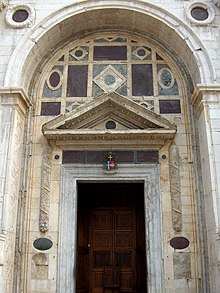Tempio Malatestiano

The Tempio Malatestiano ( Italian ' Malatesta Temple') is the cathedral church of the Italian city of Rimini . It was officially named after St. Francis . However, it usually bears the name of Sigismondo Malatesta , who commissioned the famous theorist and architect Leon Battista Alberti around 1450 with a new building, which was decorated by other Renaissance artists such as Agostino di Duccio and Piero della Francesca .
history
San Francesco was originally built in the 13th century as a Gothic church that belonged to the Franciscans . This church was square in plan, with no side chapels, had a single nave and three apses , the middle of which probably contained frescoes by Giotto , who is also credited with the crucifix now in the second chapel on the right.
Malatesta commissioned Alberti to redesign the building and use it to build a kind of personal mausoleum for him and his mistress and later third wife Isotta degli Atti . Alberti planned to build a dome similar to the Pantheon in Rome , which would be the largest of its kind in Italy, but which was never built. The upper part of the facade was left unfinished, and the sarcophagi of Sigismondo Malatesta and Isotta were to be placed in the two blind arcades to the side of the entrance, but they are now inside. Another sarcophagus houses the bones of the philosopher Georgios Gemistos Plethon .
The marble for the church comes from the Roman ruins in Sant'Apollinare in Classe near Ravenna and in Fano .
The church was given the title of Basilica minor in 2002 by Pope John Paul II .
literature
In Vendetta: High Art and Low Cunning at the Birth of the Renaissance , author Hugh Bicheno devotes an entire chapter to the Malatesta Temple. The chapter is called "Isotta and the Tempio" and links the prehistory of the temple construction around the love affair between Malatesta and Isotta degli Atti with an accurate and pointed description of the inner life of the temple.
The author uses the design of the temple to describe Malatesta's character. The strong tendency to self- glorify the condottiere becomes particularly evident, so that the author speaks of the temple of the "Sigismondo cult". Malatesta preferred Roman and Greek motifs to Christian and religious representations and can thus be described as one of the pioneers of the Renaissance . Significantly, the reliefs contain images of Malatesta: in one scene of the triumph of the Roman general Scipio over the Carthaginian Hannibal (Sigismondo as Scipio himself) and in another as a warrior in Roman armor at the feet of the goddess Minerva .
Web links
Individual evidence
- ^ Hugh Bicheno: Vendetta: High Art and Low Cunning at the Birth of the Renaissance . Weidenfeld & Nicolson, London 2007, ISBN 978-0-297-84634-5 , pp. 168-180 (English).
Coordinates: 44 ° 3 ′ 34.6 " N , 12 ° 34 ′ 12.8" E
